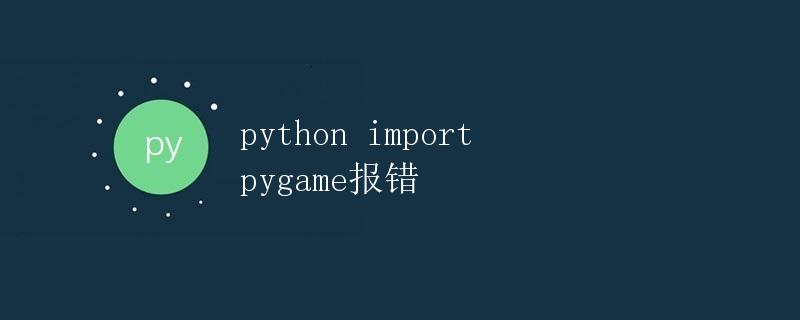python import pygame报错

1. 引言
随着互联网的普及以及计算机的快速发展,游戏已经成为许多人日常娱乐和放松的一个重要方式。而Python作为一门简单易学但功能强大的编程语言,它的pygame模块为我们提供了一个方便的方式来编写游戏。
这篇文章将详细介绍如何使用Python中的pygame模块来创建一个简单的游戏,并说明其中的关键步骤和注意事项。
2. 安装pygame模块
在开始之前,我们需要先安装pygame模块。可以通过在命令行中运行以下命令来安装:
pip install pygame
安装完成后,我们就可以开始编写游戏了。
3. 创建游戏窗口
在使用pygame编写游戏之前,我们首先需要创建一个窗口,作为游戏的显示界面。下面是创建一个游戏窗口的代码示例:
import pygame
pygame.init()
# 设置窗口尺寸
screen_width = 800
screen_height = 600
# 创建游戏窗口
screen = pygame.display.set_mode((screen_width, screen_height))
pygame.display.set_caption("我的游戏")
# 游戏主循环
running = True
while running:
for event in pygame.event.get():
if event.type == pygame.QUIT:
running = False
pygame.quit()
上述代码的主要步骤如下:
1. 导入pygame模块并初始化。
2. 设置窗口的尺寸。
3. 创建游戏窗口并设置标题。
4. 进入游戏的主循环,监听退出事件。
4. 绘制游戏元素
在创建了游戏窗口后,我们接下来需要绘制游戏所需要的元素,比如游戏角色、背景、障碍物等。pygame提供了一系列的绘制函数来实现这些功能。
下面是一个绘制游戏元素的简单示例,其中绘制了一个小球和一个矩形:
import pygame
pygame.init()
# 设置窗口尺寸
screen_width = 800
screen_height = 600
# 创建游戏窗口
screen = pygame.display.set_mode((screen_width, screen_height))
pygame.display.set_caption("我的游戏")
# 游戏元素的位置和大小
ball_x = 400
ball_y = 300
ball_radius = 20
rect_x = 200
rect_y = 400
rect_width = 100
rect_height = 20
# 游戏主循环
running = True
while running:
for event in pygame.event.get():
if event.type == pygame.QUIT:
running = False
# 绘制背景
screen.fill((0, 0, 0))
# 绘制小球
pygame.draw.circle(screen, (255, 0, 0), (ball_x, ball_y), ball_radius)
# 绘制矩形
pygame.draw.rect(screen, (0, 255, 0), (rect_x, rect_y, rect_width, rect_height))
pygame.display.flip()
pygame.quit()
上述代码的关键步骤如下:
1. 定义游戏元素的位置和大小。
2. 在游戏主循环中,使用pygame提供的绘制函数绘制游戏元素。
3. 使用pygame.display.flip()函数刷新窗口,以显示绘制的游戏元素。
5. 键盘输入和移动逻辑
在大多数游戏中,我们需要对键盘输入做出响应,并根据输入来控制游戏元素的移动。下面是一个简单的示例,演示了如何对键盘输入做出响应并移动矩形:
import pygame
pygame.init()
# 设置窗口尺寸
screen_width = 800
screen_height = 600
# 创建游戏窗口
screen = pygame.display.set_mode((screen_width, screen_height))
pygame.display.set_caption("我的游戏")
# 游戏元素的位置和大小
rect_x = 200
rect_y = 400
rect_width = 100
rect_height = 20
# 游戏主循环
running = True
while running:
for event in pygame.event.get():
if event.type == pygame.QUIT:
running = False
if event.type == pygame.KEYDOWN:
if event.key == pygame.K_LEFT:
rect_x -= 10
if event.key == pygame.K_RIGHT:
rect_x += 10
# 绘制背景
screen.fill((0, 0, 0))
# 绘制矩形
pygame.draw.rect(screen, (0, 255, 0), (rect_x, rect_y, rect_width, rect_height))
pygame.display.flip()
pygame.quit()
上述代码的主要步骤如下:
1. 在游戏主循环中,监听键盘事件。
2. 判断键盘事件的类型和按下的键,并根据按下的键来修改游戏元素的位置。
3. 响应键盘事件后,重新绘制游戏窗口以更新游戏元素的位置。
6. 碰撞检测和游戏逻辑
在许多游戏中,碰撞检测是非常重要的一部分。它用于检测游戏元素之间的碰撞,并根据碰撞结果来决定游戏的逻辑。
下面是一个简单的示例,演示了如何进行碰撞检测并改变小球的运动方向:
import pygame
pygame.init()
# 设置窗口尺寸
screen_width = 800
screen_height = 600
# 创建游戏窗口
screen = pygame.display.set_mode((screen_width, screen_height))
pygame.display.set_caption("我的游戏")
# 游戏元素的位置和大小
ball_x = 400
ball_y = 300
ball_radius = 20
ball_dx = 5 # 小球在x轴方向的速度
ball_dy = 5 # 小球在y轴方向的速度
rect_x = 200
rect_y = 400
rect_width = 100
rect_height = 20
# 游戏主循环
running = True
while running:
for event in pygame.event.get():
if event.type == pygame.QUIT:
running = False
# 移动小球
ball_x += ball_dx
ball_y += ball_dy
# 边界碰撞检测
if ball_x - ball_radius < 0 or ball_x + ball_radius > screen_width:
ball_dx *= -1
if ball_y - ball_radius < 0 or ball_y + ball_radius > screen_height:
ball_dy *= -1
# 碰撞检测
if rect_x < ball_x < rect_x + rect_width and rect_y < ball_y + ball_radius < rect_y + rect_height:
ball_dy *= -1
# 绘制背景
screen.fill((0, 0, 0))
# 绘制小球
pygame.draw.circle(screen, (255, 0, 0), (ball_x, ball_y), ball_radius)
# 绘制矩形
pygame.draw.rect(screen, (0, 255, 0), (rect_x, rect_y, rect_width, rect_height))
pygame.display.flip()
pygame.quit()
上述代码的关键步骤如下:
1. 定义了小球在x轴和y轴上的速度(ball_dx和ball_dy)。
2. 在游戏主循环中,通过修改小球的位置实现小球的移动。
3. 在边界碰撞检测部分,检查小球是否触碰到了窗口的边界,如果是,则改变小球在该方向上的速度,以实现反弹效果。
4. 在碰撞检测部分,检查小球是否与矩形元素发生了碰撞,如果是,则改变小球在y轴上的速度,实现小球反弹效果。
5. 在绘制游戏窗口的最后一步中,使用pygame.display.flip()函数刷新窗口,以显示更新后的游戏元素的位置。
7. 总结
本文详细介绍了如何使用Python中的pygame模块来编写游戏。通过创建游戏窗口、绘制游戏元素、响应键盘事件、进行碰撞检测和实现游戏逻辑等关键步骤,我们可以轻松地编写出小型的游戏程序。
然而,本文仅仅是对pygame的简单介绍,pygame还有更多的功能和用法,如音效、碰撞检测的高级算法等。
 极客笔记
极客笔记